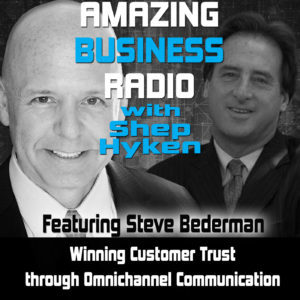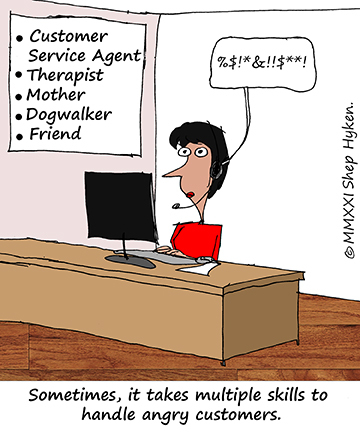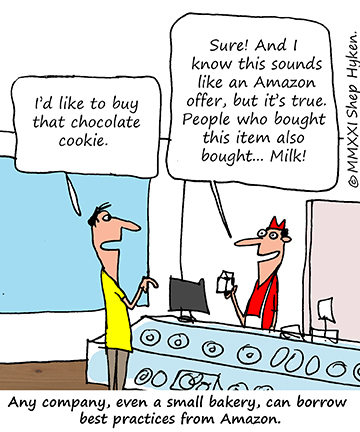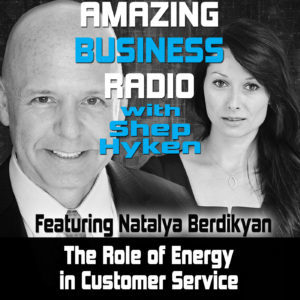Shep Hyken's Blog, page 83
June 15, 2021
Amazing Business Radio: Steve Bederman
 Winning Customer Trust through Omnichannel Communication
Winning Customer Trust through Omnichannel CommunicationUtilizing Omnichannel Communication to Connect with Customers
Shep Hyken interviews Steve Bederman, President and CEO of NobelBiz, a Contact Center Technology Company. He is also a published author, an accomplished leader, and a highly regarded Contact Center industry innovator. They discuss the value of omnichannel communication in the different stages of the customer journey.






 Top Takeaways:A customer gives us the gift of trust when they choose us. We must return that trust with integrity, passion, relentless effort, and a sound process.Society has allowed companies to give customers mediocrity. Returning to do business with companies that do not provide great customer service sets the tone that it is okay to do less.With so much competition out there, every business cannot afford to provide a bad customer experience.You can’t provide a repeatable and sustainable experience without creating process and training around it.Trust is the outcome of doing the next right thing. Do the right thing often enough and in a sustainable way that it becomes predictable for your customers.Companies need to get in touch with how their customers want to communicate with them whether it is via phone, email, chat, social media, or other mediums.Omnichannel communication is having all the channels that a customer can connect with your brand in a centralized dashboard.Quotes:
Top Takeaways:A customer gives us the gift of trust when they choose us. We must return that trust with integrity, passion, relentless effort, and a sound process.Society has allowed companies to give customers mediocrity. Returning to do business with companies that do not provide great customer service sets the tone that it is okay to do less.With so much competition out there, every business cannot afford to provide a bad customer experience.You can’t provide a repeatable and sustainable experience without creating process and training around it.Trust is the outcome of doing the next right thing. Do the right thing often enough and in a sustainable way that it becomes predictable for your customers.Companies need to get in touch with how their customers want to communicate with them whether it is via phone, email, chat, social media, or other mediums.Omnichannel communication is having all the channels that a customer can connect with your brand in a centralized dashboard.Quotes:“‘Make a promise, keep a promise’ should be everyone’s creed.”
“The differentiating factor of your business should be how you care for your customers.”
“We can’t promise perfection but we can promise that we will always give the customers all that we have to provide them the best experience with our business.”
“When you do something for somebody, always try to do more, not less.”
“Most companies claim that they have good customer service but the true defining measure of making the customer feel valued is behavior.”
“Pay attention to your customer. Listen to what mode of communication is the most comfortable and convenient way for them and offer that option.”
“We are lucky to live and do business in a world that allows us a wide range of ability to connect with each other.”
“Get comfortable with saying yes to your customers and then, follow through.”
About:Steve Bederman is the President and CEO of NobelBiz, a Contact Center Technology Company that offers state-of-the-art solutions for companies that want to keep their clients happy. His personal creed is ‘Make a Promise, Keep a Promise’ and he applies it in both his personal and professional life.
Shep Hyken is a customer service and experience expert, New York Times bestselling author, award-winning keynote speaker, and your host of Amazing Business Radio.
This episode of Amazing Business Radio with Shep Hyken answers the following questions … and more:
What is the best communication strategy for customer service?How has social media changed the way businesses do customer service?How do you build customer trust and loyalty?What is omnichannel customer service?What is the difference between multichannel and omnichannel customer service?The post Amazing Business Radio: Steve Bederman appeared first on Shep Hyken.
June 14, 2021
5 Top Customer Service Articles of the Week 6-14-2021
Each week I read many customer service and customer experience articles from various resources. Here are my top five picks from last week. I have added my comment about each article and would like to hear what you think too.
Actual vs. Intended Customer Experience: The Major Disconnect by Tara Sporrer
(MarTech Series) Harvard Business Review found that delighting your customers doesn’t build loyalty; reducing their effort—the work they must do to get their problem solved—does. It’s crucial to close the gap between the understanding of the actual customer service experience and the intended customer experience.
My Comment: This is an important topic to understand. As the author of this article calls it, there is a customer service gap, a disconnect. It’s the gap between what a company’s leadership perceives their customer service and experience to be versus what the customer perceives it to be. Usually, the leadership thinks they are much better than they are. Ouch!
Why Brands Must Embrace Personalization Before It’s Too Late by Katrina Wong
(AdAge) Personalization is now table stakes, and according to a new study by Twilio Segment of 3,000 businesses and consumers, 75% of businesses feel the same.
My Comment: Personalization continues to be a hot topic. Our recent study/survey confirmed that to customers, this is “very important” or “important” to their decision to come back to a business. This article looks at some reason why with some technical “how to.” Personalization may not quite be table stakes for a good customer experience, but it’s a definite differentiator.
Forget Brand Loyalty. Here’s Why You Should Strive for ‘Brand Intimacy’ Instead by Sophie Downes
(Inc. Magazine) A study by MBLM found that respondents formed emotional connections with a greater number of brands during the pandemic (23 percent more than in MBLM’s previous study) and deepened their existing intimate relationships with brands.
My Comment: To create true customer loyalty, it’s about an emotional connection between a brand and a customer. This article refers to that emotional connection as “intimacy.” As the title implies, forget brand loyalty. Go for brand intimacy. That’s how you create the kind of loyalty that gets customers to come back again and again.
Ways Proactive Customer Service Can Lead to Customer Retention and Growth by Ashwini Dave
(Business 2 Community) A lot of times, businesses struggle to understand how they can retain their existing customers in a market that is so competitive. Sometimes, the solution can be as simple as saying “sorry, we made a mistake” even before the customer realizes it – and that is what we call Proactive Customer Service.
My Comment: One way to instill confidence in your customers is to deliver proactive customer service. It shows your thinking about the customer. You take care of problems before they happen. Or, if they do happen, you resolve them before the customer tells you about them – or maybe even before the customer ever knows. This article shares some of the benefits of practicing proactive customer service. Those benefits start with retention and growth, and that translates into dollars.
Retailers Reflect on the Future of Stores – Store Management for 2021 & Beyond by RETHINK Retail
(RETHINK Retail) A RETHINK Retail special report featuring insights from thought leaders and retail executives.
My Comment: This is a report you’ll have to download, but it’s a great one. You can always unsubscribe if you don’t want to get any other information from them. The opening headline caught my attention: When was the last time you did something for the first time? This is about creating the Agile Store in retail. Trying and experimenting with new ideas. But, if you read between the lines, much of this content can apply to any type of business.
Shep Hyken[image error] is a customer service expert, professional speaker, and New York Times bestselling business author. Go to The Customer Focus to learn more about our customer service training programs. Follow on Twitter: @Hyken
to learn more about our customer service training programs. Follow on Twitter: @Hyken
The post 5 Top Customer Service Articles of the Week 6-14-2021 appeared first on Shep Hyken.
June 11, 2021
Guest Post: Hang It on the fridge
This week we feature an article by John O’Leary, a speaker, coach, and best-selling author. He shares an excerpt from his #1 bestselling book In Awe.
Scott worked at the valet stand.
When he saw [me] this nine-year-old kid wrapped with bandages, eyes reddened from the physical therapy session he’d just endured, Velcro-strapped into a wheelchair, waiting for a ride home, he must have recognized that this kid needed some extra attention.
Although Scott was incredibly old (a nineteen-year-old is ancient in the eyes of a nine-year-old), he would take time away from his job to keep me company. He would pull a chair alongside my wheelchair, look out at the driveway filled with emergency vehicles and we’d pretend all those ambulances were part of our army and that we were planning an ambush. Scott was my sergeant, and I was his lieutenant. He took orders from me.
For a little boy who had a team of doctors, nurses, and therapists always telling him what to do, it was a welcome reversal.
When my ride finally arrived, Scott would do one more thing that always made my day: He’d let me talk on his walkie-talkie.
He’d hold it in front of me, push the talk button, and say, “Okay, we’re live. Go for it!”
With great enthusiasm, I’d say, “Johnny to base. Johnny to base. Send reinforcements. Enemy approaching. Over and out.”
We’d laugh uncontrollably as some angry security officer would hop on and yell: “Kid, get off the radio!”
With tears no longer in my eyes and a big, beaming smile on my face, I would be wheeled by Scott toward my parents’ car and he would help me in and tell me he looked forward to seeing me the next day.
It doesn’t seem like that big of a deal when I look back on it. They were, after all, just small moments of kindness. Yet to a struggling child, they made a huge difference.
Scott was a college student, trying to earn some spending money for the weekends. But even at that age, he knew that work wasn’t just about putting in the time and picking up a paycheck.
He knew that any job, when performed with excellence, could become something greater. He knew there were no insignificant people, that small acts mattered and little things made a big difference.
I believe every job we do matters, and all work is sacred. But too often, we can get caught up in busy work and neglect the essential life-giving work begging to be attended to. Sometimes we must turn away from the demands and instead focus on what truly makes a difference.
The kind of work that makes us immensely proud.
Remember when you were little and were excited about something you created? What words would you say as you took it from your backpack and handed it to your parent?
Look what I made!
I still hear those words from my children every time they create art, whether at school or at our kitchen table. They smile broadly, hand their picture to me, describe the scene they created, and light up as I compliment it. Before walking over to the fridge to hang it up proudly, they do one more thing every artist does after completing a masterpiece.
They put their name on it, to claim it as theirs.
When was the last time you walked out of work feeling that kind of satisfaction?
When was the last time you finished a project, printed your name on the bottom of it, ran to your boss, assistant, or colleague, put it on their desk, and pumped your fist, proclaiming, “Boom! That’s how you crush an Excel sheet, baby!” or “That’s how you teach the Pythagorean theorem, my man!” or “That’s how you do a patient hand-off to afternoon staff!”
Why not?
Why are these statements laughable instead of commonplace?
…Martin Luther King Jr. wrote extensively about the sacred value of work. He reminds us of the immense opportunity it holds for each of us:
“When you discover your life’s work, set out to do it so well that the living, the dead or the unborn couldn’t do it better. And no matter what it is, never consider it insignificant because if it is for the upbuilding of humanity, it has cosmic significance. And so if it falls your lot to be a street sweeper, sweep streets like Raphael painted pictures. Sweep streets like Michelangelo carved marble. Sweep streets like Beethoven composed music. Sweep streets like Shakespeare wrote poetry. Sweep streets so well that all the hosts of heaven and earth will have to pause and say, “Here lived a great street sweeper, who swept his job well.”
Any work we do, when we do it well, has cosmic significance.
Do you feel this way about your work? Are you sweeping streets like Raphael painted in your sales job, in your role as a custodian, or at your position in middle management?
…Our goal professionally isn’t to simply be busy and active, but effective and productive. We might equate those goals, as if they are similar, maybe even the same.
But they are vastly different.
This is an excerpt from John O’Leary’s #1 bestselling book IN AWE and many are saying this book has the message we all need right now. John also wrote #1 bestseller ON FIRE, is an in-demand live + virtual event speaker, corporate coach, host of the Live Inspired Podcast and – most importantly – husband and father of four. Find out more at www.JohnOLearyInspires.com.
 For more articles from Shep Hyken and his guest contributors go to customerserviceblog.com.
For more articles from Shep Hyken and his guest contributors go to customerserviceblog.com.
Read Shep’s latest Forbes article: Six Concepts Every Employee Of A Customer-Centric Organization Must Follow
The post Guest Post: Hang It on the fridge appeared first on Shep Hyken.
June 9, 2021
Six Ways to Handle Angry Customers
 Everybody has angry customers. Some customers are angry because they have a complaint. Some are just having a bad day. Whatever the reason, you must know how to handle angry customers.
Everybody has angry customers. Some customers are angry because they have a complaint. Some are just having a bad day. Whatever the reason, you must know how to handle angry customers.
In our customer service training workshops, we provide a number of tactics to manage these difficult customer situations. Before I get into the specifics, remember that when angry customers have their problems managed appropriately, they can become your best customers. You’re not trying to win an argument. You’re trying to win the customer. Furthermore, you’re trying to restore their confidence so they continue doing business with you in the future.
So, with that in mind, here are six ways to handle angry customers:
Make sure you’re paying attention to the customer. They deserve your complete attention. Even over the phone, they can tell if you’re distracted.Deal with the customer’s anger quickly. Acknowledge it early in your conversation. Apologize for it and begin to work on the solution, which should de-escalate the anger.Stay calm and don’t lose your cool. It’s human nature to become defensive and fight back. As mentioned, you’re not trying to win the argument. Even if customers yell, don’t yell back. They aren’t mad at you. They are mad at the situation.Listen to your customer. Actively listen and ask clarifying questions, but don’t interrupt. Wait for the appropriate time to ask. By the way, take notes, because if the customer is sharing a long story, it may be a while before you get a chance to jump in with a question.Speaking of waiting for the right opportunity to ask the question, don’t interrupt customers for any reason. When you finally do have a chance to talk, many times they will extend the courtesy of listening to you because you were courteous and listened to them.Have a positive attitude. That doesn’t mean you’re all smiles. It means you’re appropriately enthusiastic. It’s a contagious attitude that is felt by customers and helps them understand you’re there to help them. And, the right attitude promotes optimism. You want your customer to feel like they have the support of the person who’s going to help them solve their problem.Keep in mind that there are exceptions to most rules. To that point, there are just suggestions that, when used properly, will work. The goal is to manage that angry customer and end the conversation with the sense that you’ve not only fixed their problem or managed their complaint, but also proved to them that they made the right decision to do business with you. The ultimate result is when they know that if there is a problem, they don’t need to be angry. They just need to call and ask for help.
Shep Hyken is a customer service expert, keynote speaker, and New York Times, bestselling business author. For information, contact 314-692-2200. For information on The Customer Focus customer service training programs, go to www.thecustomerfocus.com. Follow on Twitter: @Hyken
customer service training programs, go to www.thecustomerfocus.com. Follow on Twitter: @Hyken
(Copyright © MMXXI, Shep Hyken)
The post Six Ways to Handle Angry Customers appeared first on Shep Hyken.
June 8, 2021
Amazing Business Radio: Dr. Jeffrey Magee
 Stress Test Your Business to Prepare for the Bad Times
Stress Test Your Business to Prepare for the Bad TimesHow to Identify Market Opportunities that Your Competitors Miss
Shep Hyken interviews Dr. Jeffrey Magee, one of today’s leading Leadership Strategists. He is the author of Your Trajectory Code and more than 30 other books. They discuss how to stress test your business in the good times so that you are empowered to provide a great experience to your clients even in the bad times.







Top Takeaways:
The global pandemic has given businesses time to focus on what customer service means and how it affects their bottom line.When businesses don’t understand customer service, they are not able to recalibrate and change their trajectory to succeed in difficult times.A personalized service compels customers to continue doing business with you. Empower your employees to provide personalized service because in business, he who goes the extra mile, wins.When the leaders are willing to jump in to make success happen, it creates a culture where everyone is invested in creating a positive experience for the customer.When you’re the customer and you have an experience that makes you say, “Wow! That’s amazing!”, make a note. When you go back to your business, think of how you can translate that to wow your own customers.The friendship factor is when your customers feel welcomed by you. This relationship makes your customers go out of their way to do business with you.Quotes:
“Everyone can adjust when they need to but a lot of times, people don’t think about other market opportunities in good times or in bad times.”
“You should still be innovating during the good times so when you are pushed to innovate in the bad times, you are equipped to find phenomenal success pathways.”
“When the leadership sets the tone, everyone goes the extra step to deliver great customer service.”
“Success starts with the right mindset and the right attitude. When you have the servant mindset, everyone wins.”
“Your legacy is what other people do with what you have given them.”
About: Dr. Jeffrey Magee is the author of more than 30 books, three college graduate management textbooks, four bestsellers, and is the Publisher of PERFORMANCE/P360 Magazine, and a Human Capital Developer for more than twenty years. He brings over two decades of Executive and Corporate Development Expertise, with the last decade working in both the start-up to the mature-growth market business sector.
Shep Hyken is a customer service and experience expert, New York Times bestselling author, award-winning keynote speaker, and your host of Amazing Business Radio.
This episode of Amazing Business Radio with Shep Hyken answers the following questions … and more:
What is a stress test in business?How do you stress test a business model?How to identify market opportunities in business?What is the role of innovation in business? How does leadership affect customer service?The post Amazing Business Radio: Dr. Jeffrey Magee appeared first on Shep Hyken.
June 7, 2021
5 Top Customer Service Articles of the Week 6-7-2021
Each week I read a number of customer service and customer experience articles from various resources. Here are my top five picks from last week. I have added my comment about each article and would like to hear what you think too.
Customer Interviews for CX: How to Conduct Interviews & How They Can Make a Difference by Jeannie Walters(Experience Investigators) Customer interviews can highlight issues in emotional ways. Customer quotes can be used to tell your customer’s story on a customer journey map or in a persona. Word clouds can help others in the organization connect with the real language customers use again and again!
My Comment: Jeannie Walters is no stranger to this weekly roundup of the best customer service and CX articles of the week. Here she talks about how to conduct a customer interview. Interesting concept! My take is that the interview is combining elements of a survey and focus group. The one-on-one process can yield some important results.
The Secret Ingredients of a CX-Led Company Culture by Steven van Belleghem(CMO from IDG) Customer experience simply does not live in a void controlled by the marketing teams. Context is everything, and the culture within a company and the day-to-day experience of employees have a huge influence on the kind of experience that is delivered to the final customer.
My Comment: Another author who has graced the Top Five list numerous times. Anything Stephen van Belleghem writes is worth reading. Here, he shares an article focused on culture. Check out this list of six “ingredients,” as he calls them. One of more is sure to whet your appetite!
Being Customer-centric Starts With A Top-Notch Employee Experiencestanley by Stanley Huang(MarTech Series) All business units depend on the creativity, productivity and attitude employees bring to the workplace. Treating your employees like your No. 1 customer can help you improve the employee experience (EX), build a customer-centric company, and capture more revenue.
My Comment: And, speaking of culture, here’s an article that emphasizes that recognizes that being customer-centric starts with the employee experience. I love the formula: Customer-Centric Mindset + Happy Employees = Company Success. Put another way, before you can have an amazing customer experience, you must start with an employee experience.
The Untapped Potential of B2B Customer Loyalty Programs by John Rolston and Jon Glick(strategy+business) In a recent PwC customer survey, almost 60% of B2B customers reported they had never had an experience with a brand that made them feel special. That’s an alarmingly high percentage of customers who’ve been given no particular reason to stick around.
My Comment: A loyalty program for B2B? Absolutely! Loyalty programs are not just for consumers. Many of the same principles in a B2C loyalty program apply to B2B. The article shares some of the benefits as well as five action steps for making a B2B loyalty program successful.
How to Upsell and Cross-Sell (4 Best Practices) by Jared Atchison(Business 2 Community) If you want people to spend more on each order, you have to learn how to put your value proposition on display. Depending on how you promote your products or services, you may have to adjust your marketing strategies.
My Comment: “Would you like fries with that?” That’s the famous McDonald’s upsell question. That question has accounted for millions and millions of extra sales. It’s an upsell, and one that makes the customer glad they bought. (Who doesn’t love those delicious fries?!) My take on the upsell and cross-sell is that if you don’t do it when you should, it’s bad customer service. Done the right way, and for the right reason, it should baked into the customer service experience. Here, the author shares his suggested best practices.
BONUSBipartisan Bill Would Elevate Federal Customer Experience by Frank Konkel(Nextgov) Legislation introduced in the Senate could infuse the federal government with some of the same customer experience principles in use by leading private sector companies.
My Comment: Anytime I hear that the government is going to focus some efforts on customer service and CX, I get excited. Looks like they are creating a CCXO (Chief Customer Experience Officer) Good for them! They have to overcome a reputation and work hard to train the government employees. Service and experience have not typically been strengths of consumers/citizens dealing with government agencies. I’m looking forward to seeing how this works out.
Shep Hyken[image error] is a customer service expert, professional speaker, and New York Times bestselling business author. Go to The Customer Focus™ to learn more about our customer service training programs. Follow on Twitter: @Hyken
The post 5 Top Customer Service Articles of the Week 6-7-2021 appeared first on Shep Hyken.
June 4, 2021
Guest Post: How to Improve First Call Resolution (FCR) Using Knowledge Management System
This week we feature an article by Pratik Salia, a CX professional and Assistant General Manager at Knowmax. He discusses why first call resolution is important and what companies can do to resolve their customers’ queries in the first call.
The authenticity of an organization very much depends on the quality of the customer support that it provides. An up-to-the-mark first-call resolution (FCR) must be maintained to sustain a good customer experience.
In the past, customer queries were answered through calls, nowadays customer queries are solved through any available digital channel. As the means of customer support are evolving, so is the significance of FCR.
What is first-call resolution (FCR)?As one can understand from the term, first-call resolution (FCR) indicates the potential of an organization to resolve their customers’ queries in the first call itself, dropping the necessity for the customers to make a second call for the same query.
FCR helps in determining customer satisfaction (CSAT). The higher the FCR rate, the higher is customer satisfaction which as a consequence helps in growing more trust and loyalty in the customers.
FCR also helps in determining the customer support and agents’ efficiency. Apart from these, also how satisfactory is the customer experience (CX). Thus, it has an extensive role to play in the interest of the organization.
Why is first-call resolution (FCR) essential?There are many advantages to a good FCR rate, one of them being the help that it provides to the organization in determining where the customer agents are lacking effectiveness and require more further improvement. The more the customer agents’ efficiency, the better would be the company’s FCR rate.
Other benefits are that a better FCR rate would imply that the agents’ training and learning are going well. Thus, better customer support and efficient customer agents would result in an improved customer experience.
How knowledge management helps in improving FCR?Improving FCR is a critical process for a company’s profits. FCR can be improved by a knowledge management system with its tools such as a decision tree, knowledge base.
Knowledge base helps in collecting all the important data required for customer support and organizing them in order. In this way, it becomes easier to find relevant solutions for the customers and that too in a very less time.
Decision trees help the customer agents quickly and smoothly find the correct solution for any customer’s queries simply by asking them a few yes or no questions.
Automate general queriesMany of the customer queries are simple and repetitive such as “What hours are you open?”, “Are you open on Sundays?”, etc. These would consume a lot of customer agents’ time if they answer each of them over call rather than solving complex customer queries.
Hence, self-service automation is important so that customers can find their answers easily and the customer agents are only left with complex customer queries.
The self-service can be implemented with the help of FAQs and chatbots where the customers can find their solutions only with a few clicks.
Smooth customer interactionSmooth interaction with the customers is just as important as delivering the relevant solution to the customers. Avoiding dead air and keeping the on-hold time as little as possible should be preferred.
Dead Air is the total duration of silence in a call. On-hold time is defined as the time that the customer has to wait on hold while the customer agents need assistance from any supervisor or their call is connected to someone else.
Customers get a feeling of satisfaction when their problems are resolved by the customer care agents without any fuss.
Customer agent trainingCustomer care agents should be given good training and learning. When a customer agent is not able to provide the customers with relevant solutions then the customer makes another call. This impacts a great decrease in the FCR ratings. This would in turn impact the company’s profits.
Customer agents should be provided with all the necessary information required in resolving the customer queries in the first call itself.
Relevant solutions with the assistance of a knowledge baseWith a knowledge base, it becomes much easier for the customer care agents to find the most relevant solutions for their customer queries. A knowledge base helps in collecting all the information and documents. It helps them maintain an organized manner.
Having the access to all that organized information, customer agents can quickly find the most relevant solution for customer queries.
They can even refer to a decision tree. With the help of it, by asking simple yes or no questions, customer agents can understand the customer queries more clearly and thus, provide them with solutions instantly.
Gather feedbackAlong with improving the FCR, it is important to collect the customers’ feedback. Ask them for feedback right after providing them with their solutions or by sending them emails or SMS.
Gathering feedback helps in determining the drawbacks of customer support. Knowing them, it would be easier to determine where the customer agents need more improvements or training.
ConclusionFCR plays an important role in a company’s betterment. It determines whether the company is providing good customer support or not. Agents should be given proper training for resolving customer queries in the first call because a second call from the customer for the same query heavily impacts lowering the FCR rate.
Businesses should FCR should improve continuously. Knowledge management helps in improving FCR with tools such as chatbots, decision trees, knowledge base, and FAQs.
 For more articles from Shep Hyken and his guest contributors go to customerserviceblog.com.
For more articles from Shep Hyken and his guest contributors go to customerserviceblog.com.
Read Shep’s latest Forbes article: The Secret To Getting Five-Star Reviews
The post Guest Post: How to Improve First Call Resolution (FCR) Using Knowledge Management System appeared first on Shep Hyken.
June 2, 2021
How to Compete with Amazon
 Amazon has changed the way customers think. It has pushed customer service and experience to a higher level. The result is that consumers are more demanding and have higher expectations. It doesn’t matter what type of business or industry, Amazon has changed what customers want and expect from any type of business. This is actually good for everyone.
Amazon has changed the way customers think. It has pushed customer service and experience to a higher level. The result is that consumers are more demanding and have higher expectations. It doesn’t matter what type of business or industry, Amazon has changed what customers want and expect from any type of business. This is actually good for everyone.
So, how do you compete with Amazon?
Five Ways to Compete with AmazonStop Competing: The first step is to change your mindset. Stop thinking of this as an all-out competition. Even if you’re in the retail world and sell the same merchandise as Amazon, go beyond thinking about being in competition. Instead, think about how to coexist. I’ll put it in retail terms. Before the Internet, Walmart was like Amazon. It built stores near small independent retailers. Walmart was bigger and spent more on advertising. The local retailer had a choice. Compete and get squashed or adapt to what was necessary, including, but not limited to, finding ways to be different. This way, they could coexist.Be Easy to Do Business With: In my customer service keynote speeches, I often ask the audience, “What is the easiest company on the planet to do business with?” Almost everyone answers, “Amazon!” Amazon’s entire process is about ease and convenience. I’ve written an entire book on this topic, The Convenience Revolution, which teaches six principles on how to be convenient. It starts by eliminating any friction you create along your customer’s journey.Be a Part of Your Customers’ Lives: This is where Amazon excels. It has mastered being a part of its customers’ daily routines and needs. You can do the same. Over the years Amazon expanded from books to almost every type of merchandise you can think of. Last year it announced Amazon Pharmacy. More recently, it announced the opening of a retail beauty salon. These are just two examples of how Amazon is working its way into the day-to-day routines of its customers’ lives. You need to find ways of doing the same. Make doing business with you part of your customers’ regular routines.Think Like You’re Amazon: Some of the best competitive insights can come from asking your own people what they think about Amazon’s customer service and experience. Have a meeting and ask these two powerful questions: “What could Amazon do to take away our customers?” And, “What would Amazon want to change if it acquired our company?” The answers could reveal ideas you haven’t thought about before.Adapt and Adopt: So now that you’re starting to think a little like Amazon, here’s another question to add to your meeting from step four: “What do you like about doing business with Amazon?” Make a list and discuss how you can adapt the answers to suit your situation.So, the way to compete – or should I say coexist – is to learn from Amazon and adapt what you can to your own circumstances. Don’t be afraid of Amazon. Embrace Amazon. Learn from Amazon. And be better because of Amazon.
Shep Hyken is a customer service expert, keynote speaker, and New York Times, bestselling business author. For information, contact 314-692-2200. For information on The Customer Focus™ customer service training programs, go to www.thecustomerfocus.com. Follow on Twitter: @Hyken
(Copyright © MMXXI, Shep Hyken)
The post How to Compete with Amazon appeared first on Shep Hyken.
June 1, 2021
Amazing Business Radio: Natalya Berdikyan
 The Role of Energy in Customer Service
The Role of Energy in Customer ServiceUnderstanding How the 7 Levels of Energy Affects Customer Service
Shep Hyken interviews Natalya Berdikyan, founder and CEO of Life By Design Academy and Frontline Consulting. They discuss how energy affects customer service and experience.






 Top Takeaways:There are two types of energy: Catabolic energy (levels 1 and 2) is the draining and destructive energy. And, anabolic energy (levels 3 to 7) is the constructive and healing energy.Level 1: The state of being a victim. In other words, where the customer or the customer service agent feels like there is no solution.Level 2: The Antagonist – Seeing everything through the lens of conflict. This is the ‘I win, you lose’ state.Level 3: The Rationalizer – People start to take responsibility for their thoughts, feelings, and actions. Therefore, this is where collaboration begins.Level 4: The Helper – Empathy kicks in. This level is about providing service. It is all about making sure that customers win. People at this level are prone to becoming overwhelmed from giving too much.Level 5: The Collaborator – Whatever challenges your customer is facing, you always find an opportunity for improvement. This level is about providing a win-win solution.Level 6: The Connector – This is where customer service is there to support the customers and connect with other departments in the company who can help.Level 7: The Creator State – This is where winning and losing are an illusion. It is knowing that you are doing the best you can no matter the result.Quotes:
Top Takeaways:There are two types of energy: Catabolic energy (levels 1 and 2) is the draining and destructive energy. And, anabolic energy (levels 3 to 7) is the constructive and healing energy.Level 1: The state of being a victim. In other words, where the customer or the customer service agent feels like there is no solution.Level 2: The Antagonist – Seeing everything through the lens of conflict. This is the ‘I win, you lose’ state.Level 3: The Rationalizer – People start to take responsibility for their thoughts, feelings, and actions. Therefore, this is where collaboration begins.Level 4: The Helper – Empathy kicks in. This level is about providing service. It is all about making sure that customers win. People at this level are prone to becoming overwhelmed from giving too much.Level 5: The Collaborator – Whatever challenges your customer is facing, you always find an opportunity for improvement. This level is about providing a win-win solution.Level 6: The Connector – This is where customer service is there to support the customers and connect with other departments in the company who can help.Level 7: The Creator State – This is where winning and losing are an illusion. It is knowing that you are doing the best you can no matter the result.Quotes:“Everything is energy. It is important to understand the energy that you and others bring to the situation.”
“People like being around people with great energy. Even if you don’t have the exact solution for the customer, let them know that you are on their side. This creates a positive experience.“
“Energy not only plays an important role in creating a better experience for the customer, but it also creates a positive experience for yourself. “
“Listening to what level of energy your customer is at is your guide on how to react effectively and provide solutions. “
“Don’t let your internal and external influences dictate how you interact with other people. You are in control of each interaction you have with your customers. “
“If we are aware of how we feel and how our thoughts affect our feelings and actions, the world would be a more joyful, passionate, and purposeful place. “
About:Natalya Berdikyan is the founder and CEO of Life By Design Academy and Frontline Consulting. She helps individuals and organizations grow to their full potential beyond existing borders and boundaries.
Shep Hyken is a customer service and experience expert, New York Times bestselling author, award-winning keynote speaker, and your host of Amazing Business Radio.
This episode of Amazing Business Radio with Shep Hyken answers the following questions … and more:Does energy play a role in customer service and experience?What are the 7 levels of energy?Can internal or external factors influence a person’s energy?How do you manage energy to provide the best customer experience?What can block a person’s energy?The post Amazing Business Radio: Natalya Berdikyan appeared first on Shep Hyken.
May 31, 2021
5 Top Customer Service Articles of the Week 5-31-2021
Each week I read a number of customer service and customer experience articles from various resources. Here are my top five picks from last week. I have added my comment about each article and would like to hear what you think too.
5 Ways to Drive Brand Loyalty and Customer Lifetime Value by Ian Simons(Ad Age) Here are 5 tips for marketing organizations looking to maximize their Discovery Commerce opportunity from Aubrie Richey, VP of media for TechStyle Fashion Group that brought us brands like Fabletics and Savage X Fenty.
My Comment: We kick off this week’s Top Five roundup with an article that could fall under the category of marketing, however, what drives loyalty and increases average lifetime value is the customer experience. Take a close look at number four, which is about optimizing for lifetime value, not just the cost of acquisition for a new customer. (I bet you’ll find keeping your existing customers is far less expensive than acquiring new ones.)
How to Speak Human: Words You Should Never Say to Customers by Joseph Michelli, Ph.D.(Linkedin Pulse) Customer service scripts are tempting from the perspective of experience consistency, but it is hard to be authentic and inspired when you are reading someone else’s words. If you are striving for customer experience excellence, here are 5 phrases to shed.
My Comment: Dr. Joseph Michelli is no stranger to this weekly roundup. This week he posted a great article about what never to say to customers. These are what I refer to as customer loyalty killers. I can’t imagine that you’ll disagree with any of them. Which one do I hate most? When someone says, “Our policy does not allow me to…” I’m sure you’ll have a few to add to his list.
4 Ways To Improve Your Customer Effort Score by Scott Clark(CMSWire) The Customer Effort Score (CES) is seen as a business-critical metric that is a key indicator of customer loyalty and directly correlates to whether a customer will continue to do business with a brand. This article looks at the ways that the CES can be improved.
My Comment: The idea behind knowing your customer effort score is to determine the amount of friction your customers go through to interact with your organization, usually because of a customer complaint or support issue. My belief is that all interactions of the customer’s journey should be considered. You’ll find some of that philosophy in this excellent article that includes four ideas to start your thinking about how to be easier to do business with.
Chatbots In Customer Service – Everything You Need To Know! by Stephanie Falkner(Business 2 Community) This article outlines how you can benefit from a chatbot in customer service — during and after COVID times. Furthermore, we’ll share some tips on how to implement your own chatbot.
My Comment: Even if this isn’t “everything you need to know” about chatbots, there is still quite a bit of information in this short and information-filled article. Chatbots have come a long way over the past years. If you think that all they do is respond to customers’ questions and requests, then this is an article you will enjoy.
How E-Commerce, M-Commerce and S-Commerce Are Setting New Customer Experience Standards by David Fletcher(Total Retail) The ways that people can buy online keep evolving, which means there are more CX touchpoints to consider than ever. Traditional e-commerce, mobile commerce (m-commerce), and social commerce (s-commerce) each have their own customer expectations that merchants must meet in order to stay competitive.
My Comment: I’ve said for years that customers keep getting smarter when it comes to customer service and experience. They’ve learned from the best traditional brick-and-mortar e-commerce retailers. And, now there are two more experiences that are changing expectations: M-Commerce (where M stands for mobile) is driving the need for multiple channels of communication, and S-Commerce (where S stands for social) is focused on social media platforms as a way to attract customers to a brand’s site. The retail world continues to change.
Shep Hyken[image error] is a customer service expert, professional speaker, and New York Times bestselling business author. Go to The Customer Focus™ to learn more about our customer service training programs. Follow on Twitter: @Hyken
The post 5 Top Customer Service Articles of the Week 5-31-2021 appeared first on Shep Hyken.



